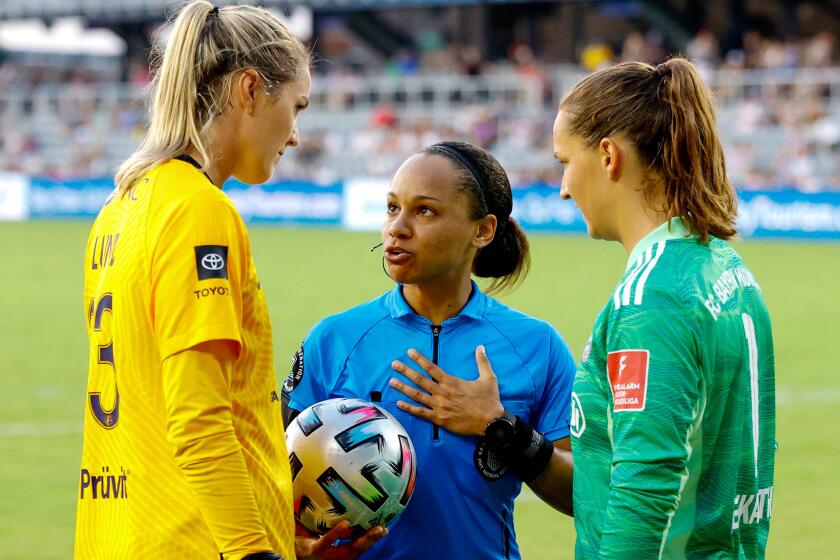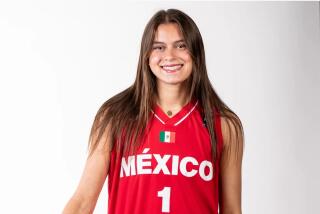Mia Fishel spurning NWSL for Mexico’s Liga MX could have a long-lasting impact

The timing seemed perfect for Mia Fishel.
Last summer she announced she would leave UCLA after her junior season. Then less than a month after her final game, Amanda Cromwell, Fishel’s coach with the Bruins, was named the new manager of the Orlando Pride. So it was no surprise when the Pride selected Fishel in the first round of the NWSL draft two weeks later.
But that’s as far as the fairytale went because in mid-January, Fishel spurned Orlando and the NWSL to sign with Tigres of Mexico’s Liga MX Femenil, a decision that could have major implications for both leagues.
For the NWSL, Fishel is a dynamic, 20-year-old forward and rising prospect in the national team program who got away. She was the first big-name U.S. player to spurn a domestic team for Mexico’s six-year-old league.
For the newly ambitious Mexican league, Fishel’s signing could quicken its development, turning Liga MX into a rival of more-established leagues in the U.S. and Europe, both on the field and in the pursuit of top players.
“Our level now needs to be elevated by players like Mia, or any American player that is playing professionally,” said Mikel Arriola, Liga MX’s executive president. “We have to grow. The example of Mia is going to generate not only an individual case, but a pattern in the Mexican women’s league.”
Arriola announced last spring that the 18 teams in the Liga MX Femenil, which primarily had been established to develop Mexican players, could each sign as many as two foreign-born players. That change came too late to help many teams in the fall season; by mid-September, halfway through the 17-game season, just 15 of the league’s 495 players were foreign-born.
However six weeks into this season, 15 of the 18 teams have at least one foreigner, including Nigerian international Uchenna Kanu, Fishel’s teammate at Tigres, and former NWSL players Sarah Luebbert and Andrea Hauksdottir, who both play for Club América. But Fishel, a Golden Ball winner in two age-group CONCACAF Championships and a two-time finalist for U.S. Soccer’s best young player award, is by far the biggest signing.
Soccer referee Natalie Simon is accustomed to being different and carrying a heavy burden as the highest-ranked Black American woman in her field.
“Tigres came in very strong with a presentation about the Tigres family, the media recognition that they have, playing in stadiums every game and their training as well,” said Fishel, who scored twice in her second game in Mexico. “I knew that coming in, there was going to be a lot of questions about, you know, ‘is the league going to develop her?’ But the training and the players are very intense. It’s very serious here.”
The money? Not so much. And that could quickly blunt the league’s aspirations.
When the league formed in 2016, players made between $25 and $100 a month, according to the Federal Commission of Economic Competition, wages so meager they inspired a government investigation that last fall resulted in fines of $8.9 million against eight individuals and 17 clubs — including Tigres — for “their responsibility in conducting absolute monopolistic practices” and for “imposing maximum wage caps for women players.”
Last October, the Mexican financial journal El Economista, citing industry sources, reported that salaries had risen to between $343 and $7,348 a month. Although some foreign players earn more than that, the average monthly pay is about $1,225, El Economista said.
That last figure trails both Spain’s La Liga Femenina, where the base pay for women players is about $18,000 a season, and the NWSL, where a new collective bargaining agreement sets the minimum salary at $35,000 a season and the average compensation package at $54,000. But it’s a step in the right direction, said Antonio Sancho, the sporting director for Tigres, which has played in seven of the eight semiannual Liga MX Femenil finals, winning four of them.
“We are paying better,” said Sancho, a former star midfielder for the men’s club. “That’s why we could bring Mia here. Or Uchenna. That league has opened that part and we are trying to, with our resources, our funds, make the best team we can.”
Cromwell confirmed that, in Fishel’s case at least, Tigres were generous with those funds.
“It’s a contract with more money than she could make in Orlando,” the former UCLA coach told the Orlando Sentinel, adding that the offer “is going to speak volumes. And it did.”
We have to grow. The example of Mia is going to generate not only an individual case, but a pattern in the Mexican women’s league
— Mikel Arriola, Liga MX’s executive president
If Liga MX clubs remain as aggressive, they could continue competing with the NWSL for North America’s top players.
Arriola, the president for Liga MX’s 18 men’s and women’s teams, estimates the league’s owners have invested around $20 million in their women’s teams. But those teams are not independent of the men’s clubs, instead sharing space under the same organizational umbrella. Arriola wants to end that practice.
“We want to generate our own income sources and that’s going to happen this year because we have a marketing strategy focused on our women’s league to generate our own income. And to elevate, obviously, the investment on the teams, to elevate the investment in salaries, in infrastructure, etc.,” he said.
Liga MX Femenil already has made great strides since its first season in 2017, especially in a country that long seemed hesitant to embrace women’s soccer. Although the average regular-season attendance has never risen above 2,250, about a third of what the 10-year-old NWSL averaged in 2019, the last pre-COVID season, the final for the 2018 Clausura tournament drew a crowd of 51,211, the largest for a women’s club match anywhere in the world.
Arriola, a former politician who loves to quote statistics, has several that indicate women’s soccer is building a strong foundation in Mexico. Two-thirds of the country’s soccer fans follow the Liga MX Femenil, he said, with women favoring the league over the men’s game by a wide margin. Overall, he added, the league has a social media following of more than 1 million.
“What made people change their mind was actually having a women’s team,” the president said. “Mexico is the best example and the best piece of evidence that opening women’s sports and women’s football is a great decision in terms of fan engagement. And in terms of financial growth.”
UCLA has made former Stanford assistant coach Margueritte Aozasa the sixth women’s soccer coach in school history, replacing Amanda Cromwell.
How much financial growth will determine what happens next. The league launched a U-17 division this year, part of its mandate to grow and improve women’s soccer in Mexico, which has never won a game in World Cup or Olympic competition. And while critics say the addition of foreigners detracts from the goal by taking minutes away from domestic players, Sancho disagrees.
“When you have better level of player, the Mexican players have to grow,” he said. “So I think it is good for the growth of the league and I see it in the league this season. It is a better level, more competitive.”
Keeping it that way could get expensive. Sancho said the league understands that.
“We have to pay so [they] want to come,” he added. “We are making an effort. The sponsors are growing in Tigres Femenil. Everything goes hand in hand. We are getting there. And the monetary part is important.”









